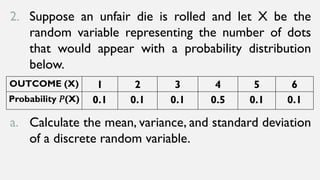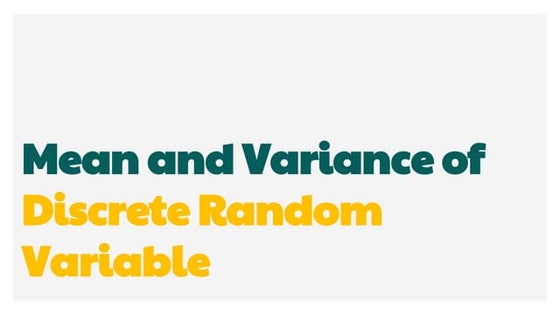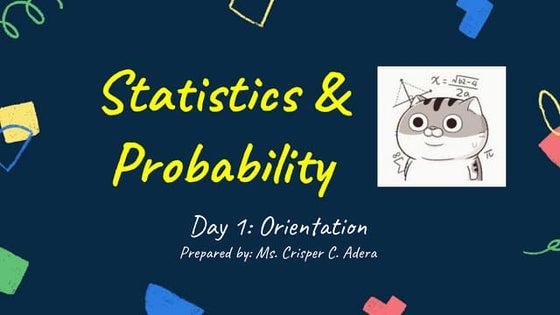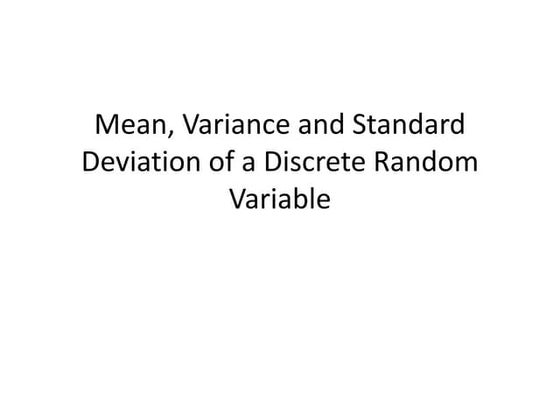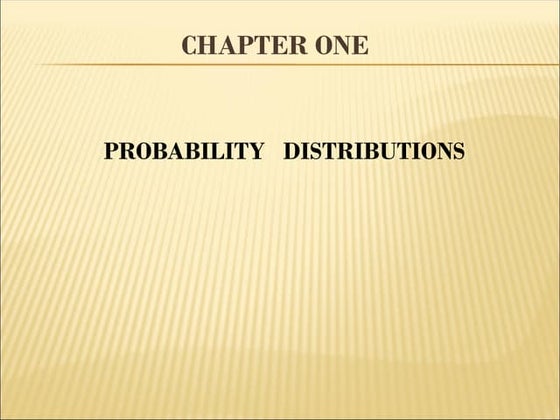STATISTICS - LESSON no 1 - MIDTERM-2.pdf
- 1. LESSON 5: CALCULATING MEAN AND VARIANCE OF A DISCRETE RANDOM VARIABLE
- 2. THE MEAN a. The average of all possible outcomes. It is otherwise referred to as the ŌĆ£expected valueŌĆØ of a probability distribution. b. Means that if we repeat any given experiment infinite times, the theoretical mean would be the ŌĆ£expected valueŌĆØ. c. Any discrete probability distribution has a mean.
- 3. THE VARIANCE AND STANDARD DEVIATION The VARIANCE of a random variable displays the variability or the dispersions of the random variables. It shows the distance of a random variable from its mean.
- 4. THE VARIANCE AND STANDARD DEVIATION a. If the values of the variance and standard deviation are HIGH, that means that the individual outcomes of the experiment are far relative to each other. In other words, the values differ greatly. b. A large value of standard deviation (or variance) means that the distribution is spread out, with some possibility of observing values at some distance from the mean.
- 5. THE VARIANCE AND STANDARD DEVIATION c. If the variance and standard deviation are LOW, that means that the individual outcomes of the experiment are closely spaced with each other. In other words, the values are almost the same values or if they do differ, the difference is small. d. A small value of standard deviation (or variance) means that the dispersion of the random variable is narrowly concentrated around the mean.
- 6. Mean, variance, and standard deviation can be illustrated by looking pattern and analyzing given illustrations and diagrams.
- 7. During Town Fiesta, people used to go to Carnival that most folks call it ŌĆ£PeryaŌĆØ. Mang Ben used to play ŌĆ£BetoŌĆōbetoŌĆØ hoping that he would win. While he is thinking about what possible outcomes in every roll would be, he is always hoping that his bet is right. X 1 2 3 4 5 6 P(X) ؤŠؤö ؤŠؤö ؤŠؤö ؤŠؤö ؤŠؤö ؤŠؤö EXAMPLE
- 8. 1.Is the probability of X lies between 0 and 1? 2.What is the sum of all probabilities of X? 3.Is there a negative probability? Is it possible to have a negative probability? 4.How will you illustrate the average or mean of the probabilities of discrete random variable? QUESTIONS:
- 9. 1.Is the probability of x lies between 0 and 1? Yes, the probability of X lies between 0 and 1. X 1 2 3 4 5 6 P(X) ؤŠؤö ؤŠؤö ؤŠؤö ؤŠؤö ؤŠؤö ؤŠؤö SOLUTION:
- 10. 2. What is the sum of all probabilities of X? ÓĘŹ ØæĘ Øæ┐ = ØæĘ Ø¤Å + ØæĘ Ø¤É + ØæĘ Ø¤æ + ØæĘ Ø¤Æ + ØæĘ Ø¤ō + ØæĘ Ø¤ö = ؤŠؤö + ؤŠؤö + ؤŠؤö + ؤŠؤö + ؤŠؤö + ؤŠؤö = ؤÅ+ؤÅ+ؤÅ+ؤÅ+ؤÅ+ؤŠؤö = ؤö ؤö ØÆÉØÆō ؤŠThe sum of all probabilities of X is exactly 1. X 1 2 3 4 5 6 P(X) ؤŠؤö ؤŠؤö ؤŠؤö ؤŠؤö ؤŠؤö ؤŠؤö SOLUTION:
- 11. 3. Is there a negative probability? Is it possible to have a negative probability? No negative probabilities because it is impossible to have it based on the characteristic of the probability of discrete random variables. SOLUTION:
- 12. In a seafood restaurant, the manager wants to know if their customers like their new raw large oysters. According to their sales representative, in the past 4 months, the number of oysters consumed by a customer, along with its corresponding probabilities, is shown in the succeeding table. Compute the mean, variance and standard deviation. Number of oysters consumed X Probabilit y P(X) 0 Ø¤É Ø¤ÅØ¤Ä 1 Ø¤É Ø¤ÅØ¤Ä 2 ؤæ ؤÅØ¤Ä 3 Ø¤É Ø¤ÅØ¤Ä 4 ؤŠEXAMPLE 1
- 13. (X) P(X) X ŌłŚ P(X) ØæŗŌłÆØ£ć. (Øæŗ ŌłÆ Ø£ć)┬▓ (Øæŗ ŌłÆ Ø£ć)┬▓ ŌłÖ Øæā(Øæŗ) 0 ؤÄ. Ø¤É Ø¤Ä Ø¤Ä ŌłÆ ؤÅ. ؤ¢ = ŌłÆؤÅ. ؤ¢ ŌłÆؤÅ. ؤ¢ Ø¤É = ؤæ. ؤÉØ¤Æ Ø¤æ. ؤÉØ¤Æ ŌłŚ ؤÄ. Ø¤É = ؤÄ. ؤöؤ¢Ø¤Æ 1 ؤÄ. Ø¤É 0.2 ؤŠŌłÆ ؤÅ. ؤ¢ = ŌłÆؤÄ. ؤ¢ ŌłÆؤÄ. ؤ¢ Ø¤É = ؤÄ. ؤöØ¤Æ Ø¤Ä. ؤöØ¤Æ ŌłŚ ؤÄ. Ø¤É = ؤÄ. ؤÅؤÉؤ¢ 2 ؤÄ. ؤæ 0.6 Ø¤É ŌłÆ ؤÅ. ؤ¢ = ؤÄ. Ø¤É Ø¤Ä. Ø¤É Ø¤É = ؤÄ. ؤÄØ¤Æ Ø¤Ä. ؤÄØ¤Æ ŌłŚ ؤÄ. ؤæ = ؤÄ. ؤÄؤÅØ¤É 3 ؤÄ. Ø¤É 0.6 ؤæ ŌłÆ ؤÅ. ؤ¢ = ؤÅ. Ø¤É Ø¤Å. Ø¤É Ø¤É = ؤÅ. ؤÆØ¤Æ Ø¤Å. ؤÆØ¤Æ ŌłŚ ؤÄ. Ø¤É = ؤÄ. ؤÉؤ¢Ø¤¢ 4 ؤÄ. ؤŠ0.4 4ŌłÆؤÅ. ؤ¢ = ؤÉ. Ø¤É Ø¤É. Ø¤É Ø¤É = ؤÆ. ؤ¢Ø¤Æ ؤÆ. ؤ¢Ø¤Æ ŌłŚ ؤÄ. ؤŠ= ؤÄ. ؤÆؤ¢Ø¤Æ
- 14. 1.What is the mean? ØØü = ÓĘŹ[Øæ┐ ŌłŚ ØæĘ(Øæ┐)] = Ø¤Ä + ؤÄ. Ø¤É + ؤÄ. ؤö + ؤÄ. ؤö + ؤÄ. Ø¤Æ ØØü = ؤÅ. ؤ¢ SOLUTION:
- 15. 2. What is the standard deviation? Ø£Ä2 = ÓĘŹ (Øæŗ ŌłÆ Ø£ć)┬▓ŌłÖ Øæā(Øæŗ) = 0.448 + 0.128 + 0.012 + 0.288 + 0.484 ØØłØ¤É Ø¤Å. ؤōؤö SOLUTION:
- 16. 3. What is the standard deviation? Ø£Ä = Žā (Øæŗ ŌłÆ Ø£ć)┬▓ŌłÖ Øæā(Øæŗ) ØæéØæģ Ø£Ä = Ø£Ä2 Ø£Ä = 1.56 ØØł = ؤÅ. ؤÉؤō SOLUTION:
- 17. Mr. Umali, a Mathematics teacher, regularly gives a formative assessment composed of 5 multiple-choice items. After the assessment, he used to check the probability distribution of the correct responses, and the data is presented below: TEST ITEM (X) Probability ØæĘ(Øæ┐) 0 0.03 1 0.05 2 0.12 3 0.30 4 0.28 5 0.22 EXAMPLE 2
- 18. 1.What is the average or mean of the given probability distribution? 2.What are the values of the variance of the probability distribution? 3.What are the values of standard deviation of the probability distribution? QUESTIONS:
- 19. X P(X) X ŌłŚ P(X) X - ØøŹ (X - ØøŹ)┬▓ (X - ØøŹ)┬▓ ŌłŚ P(X) 0 0.03 0 ŌłŚ 0.03 = 0 0 ŌłÆ 3.41 = ŌłÆ3.41 (ŌłÆ3.41)┬▓ = 11.63 11.63 ŌłŚ ؤÄ. ؤÄؤæ = ؤÄ. ؤæؤō 1 0.05 1 ŌłŚ 0.05 = 0.05 1 ŌłÆ 3.41 = ŌłÆ2.41 (ŌłÆ2.41)┬▓ = 5.81 5. ؤ¢Ø¤Å ŌłŚ ؤÄ. ؤÄؤō = ؤÄ. ؤÉؤŚ 2 0.12 2 ŌłŚ 0.12 = 0.24 2 ŌłÆ 3.41 = ŌłÆ1.41 (ŌłÆ1.41)┬▓ = 1.99 1. ؤŚØ¤Ś ŌłŚ ؤÄ. ؤÅØ¤É = ؤÄ. ؤÉØ¤Æ 3 0.30 3 ŌłŚ 0.30 = 0.90 3 ŌłÆ 3.41 = ŌłÆ0.41 (ŌłÆ0.41)┬▓ = 0.17 0. ؤÅؤĢ ŌłŚ ؤÄ. ؤæØ¤Ä = ؤÄ. ؤÄؤō 4 0.28 4 ŌłŚ 0.28 = 1.12 4 ŌłÆ 3.41 = 0.59 (0.59)┬▓ = 0.35 0.35 ŌłŚ ؤÄ. ؤÉؤ¢ = ؤÄ. ؤÅØ¤Ä 5 0.22 5 ŌłŚ 0.22 = 1.10 5 ŌłÆ 3.41 = 1.59 (1.59)┬▓ = 2.53 2.53 ŌłŚ ؤÄ. ؤÉØ¤É = ؤÄ. ؤōؤö ØøŹ = ؤæ. ؤÆؤŠØØłØ¤É = ؤÅ. ؤōؤŚ
- 20. 1.What is the mean? ØØü = ÓĘŹ[Øæ┐ ŌłŚ ØæĘ(Øæ┐)] = Ø¤Ä + ؤÄ. ؤÄؤō + ؤÄ. ؤÉØ¤Æ + ؤÄ. ؤŚØ¤Ä + ؤÅ. ؤÅØ¤É + ؤÅ. ؤÅØ¤Ä ØØü = ؤæ. ؤÆؤŠSOLUTION:
- 21. 2. What is the standard deviation? Ø£Ä2 = ÓĘŹ (Øæŗ ŌłÆ Ø£ć)┬▓ŌłÖ Øæā(Øæŗ) = ؤÄ. ؤæؤō + ؤÄ. ؤÉؤŚ + ؤÄ. ؤÉØ¤Æ + ؤÄ. ؤÄؤō + ؤÄ. ؤÅØ¤Ä + ؤōؤö ØØłØ¤É = ؤÅ. ؤōؤŚ SOLUTION:
- 22. 3. What is the standard deviation? Ø£Ä = Žā (Øæŗ ŌłÆ Ø£ć)┬▓ŌłÖ Øæā(Øæŗ) ØæéØæģ Ø£Ä = Ø£Ä2 Ø£Ä = 1.59 ØØł = ؤÅ. ؤÉؤö SOLUTION:
- 23. 1. The number of shoes sold per day at a retail store is shown in the table below. Illustrate the mean, variance, and standard deviation of this distribution. Write all the necessary formula and show the complete solution. Formula to be used: (a)Mean, (b)Variance,(c) Standard Deviation X 19 20 21 22 23 P(X) 0.4 0.2 0.2 0.1 0.1 ACTIVITY 1
- 24. 1. The Land Bank of the Philippines Manager claimed that each saving account customer has several credit cards. The following distribution showing the number of credits cards people own. a. Calculate the mean, variance, and standard deviation of a discrete random variable. X 0 1 2 3 4 P(X) 0.18 0.44 0.27 0.08 0.03 ASSIGNMENT
- 25. 2. Suppose an unfair die is rolled and let X be the random variable representing the number of dots that would appear with a probability distribution below. a. Calculate the mean, variance, and standard deviation of a discrete random variable. OUTCOME (X) 1 2 3 4 5 6 Probability Øæā(X) 0.1 0.1 0.1 0.5 0.1 0.1
- 26. 1. The number of cellular phones sold per day at the E-Cell Retail Store with the corresponding probabilities is shown in the table below. Compute the mean, variance, and standard deviation and interpret the result. (Øæź) 15 18 19 20 22 Probability Øæā(Øæź) 0.30 0.20 0.20 0.15 0.15
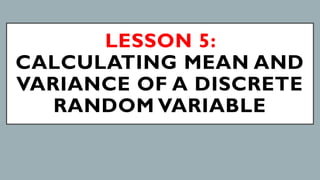












![1.What is the mean?
ØØü = ÓĘŹ[Øæ┐ ŌłŚ ØæĘ(Øæ┐)]
= Ø¤Ä + ؤÄ. Ø¤É + ؤÄ. ؤö + ؤÄ. ؤö + ؤÄ. ؤÆ
ØØü = ؤÅ. ؤ¢
SOLUTION:](https://image.slidesharecdn.com/statistics-lesson1-midterm-2-240513042704-3863d1c9/85/STATISTICS-LESSON-no-1-MIDTERM-2-pdf-14-320.jpg)





![1.What is the mean?
ØØü = ÓĘŹ[Øæ┐ ŌłŚ ØæĘ(Øæ┐)]
= Ø¤Ä + ؤÄ. ؤÄؤō + ؤÄ. ؤÉØ¤Æ + ؤÄ. ؤŚØ¤Ä + ؤÅ. ؤÅØ¤É + ؤÅ. ؤÅؤÄ
ØØü = ؤæ. ؤÆؤÅ
SOLUTION:](https://image.slidesharecdn.com/statistics-lesson1-midterm-2-240513042704-3863d1c9/85/STATISTICS-LESSON-no-1-MIDTERM-2-pdf-20-320.jpg)




